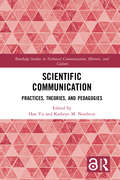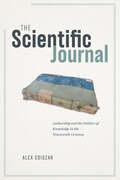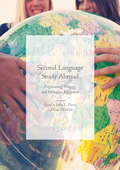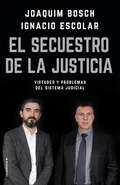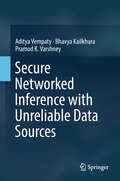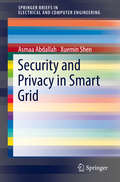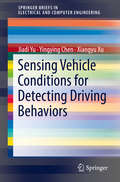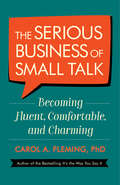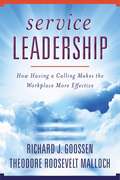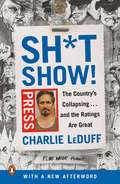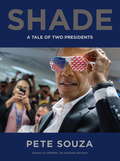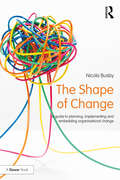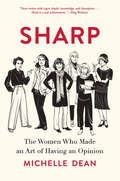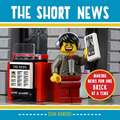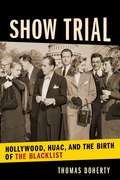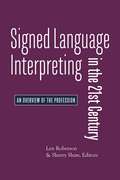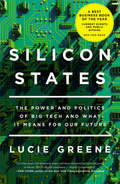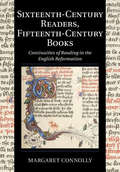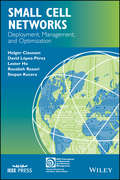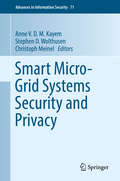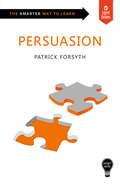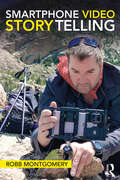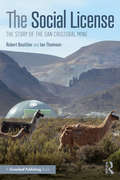- Table View
- List View
Scientific Communication: Practices, Theories, and Pedagogies (Routledge Studies in Technical Communication, Rhetoric, and Culture)
by Han Yu Kathryn M. NorthcutThis book addresses the roles and challenges of people who communicate science, who work with scientists, and who teach STEM majors how to write. In terms of practice and theory, chapters address themes encountered by scientists and communicators, including ethical challenges, visual displays, and communication with publics, as well as changed and changing contexts and genres. The pedagogy section covers topics important to instructors’ everyday teaching as well as longer-term curricular development. Chapters address delivery of rhetorically informed instruction, communication from experts to the publics, writing assessment, online teaching, and communication-intensive pedagogies and curricula.
The Scientific Journal: Authorship and the Politics of Knowledge in the Nineteenth Century
by Alex CsiszarNot since the printing press has a media object been as celebrated for its role in the advancement of knowledge as the scientific journal. From open communication to peer review, the scientific journal has long been central both to the identity of academic scientists and to the public legitimacy of scientific knowledge. But that was not always the case. At the dawn of the nineteenth century, academies and societies dominated elite study of the natural world. Journals were a relatively marginal feature of this world, and sometimes even an object of outright suspicion. The Scientific Journal tells the story of how that changed. Alex Csiszar takes readers deep into nineteenth-century London and Paris, where savants struggled to reshape scientific life in the light of rapidly changing political mores and the growing importance of the press in public life. The scientific journal did not arise as a natural solution to the problem of communicating scientific discoveries. Rather, as Csiszar shows, its dominance was a hard-won compromise born of political exigencies, shifting epistemic values, intellectual property debates, and the demands of commerce. Many of the tensions and problems that plague scholarly publishing today are rooted in these tangled beginnings. As we seek to make sense of our own moment of intense experimentation in publishing platforms, peer review, and information curation, Csiszar argues powerfully that a better understanding of the journal’s past will be crucial to imagining future forms for the expression and organization of knowledge.
Second Language Study Abroad: Programming, Pedagogy, And Participant Engagement
by John L. Plews Kim MisfeldtThis edited volume explores studying second languages abroad by critically and constructively reviewing established programming, providing theoretical and research-informed support for pedagogical and curriculum interventions, and analysing participant experiences. Over 12 chapters the contributors examine key issues including teaching approaches, learning activities, and relationships in the target language and culture. This book is most distinct in its attempt to promote diversity in approaches and experiences while drawing the common thread of learner- and learning-centredness through each chapter. The contributing authors represent a wide range of academies and discuss study abroad programs and participants in diverse cultural and geographic regions. The book’s international scope will acquaint educators and researchers with a broad variety of practices, stimulate comparison across contexts, and promote innovation.
El secuestro de la justicia: Virtudes y problemas del sistema judicial
by Ignacio Escolar Joaquim Bosch Grau¿Está la justicia española secuestrada por los políticos? Joaquim Bosch (ex portavoz de Juezas y Jueces para la Democracia) e Ignacio Escolar (director de eldiario.es) han unido fuerzas para escribir un libro necesario, incisivo y pedagógico sobre la Justicia. El sistema judicial está en crisis. Así lo denuncia esta reflexión crítica sobre un deterioro que afecta profundamente a nuestra democracia. En una escalada sin precedentes, las injerencias políticas son muy visibles, se concentran en la cúpula judicial y son especialmente peligrosas en los casos de corrupción. Por otro lado, la ciudadanía percibe que las leyes no siempre son iguales para todos. Las maniobras que tratan de capturar las instituciones judiciales están relacionadas con un fenómeno más amplio: los intentos de secuestro de la Justicia como valor. Por eso los autores también estudian: las injusticias que padecen las víctimas de violencia machista, y los que padecen abusos bancarios; los problemas en la aplicación de la prisión provisional o los excesos en los límites de la política de penas de privación de libertad; el drama de los refugiados y la criminalización de los inmigrantes; la falta de reparación de las víctimas del franquismo; la actuación de la justicia en el conflicto catalán; y los crecientes recortes de libertades. Pero El secuestro de la Justicia es también una defensa de la magnífica base del sistema judicial, esa inmensa mayoría de magistrados que no se ha dejado contaminar. Como los que llevaron los abusos bancarios a la jurisdicción europea y vencieron. O los que, sin medios suficientes, investigan la corrupción y ponen contra las cuerdas a políticos y a empresarios. La crítica ha dicho...«Relato pedagógico sobre separación de poderes.»EFE «Un texto ensayístico, pero escrito con estilo periodístico, orientado a plantear una larga serie de reflexiones y dudas sobre el llamado tercer poder.»Juan Bolea, El Periódico de Aragón «Un libro fundamentalpara entender nuestro país. No solo recomendable, sino imprescindible.»Carlos Ávila, Andamios (y la vida sigue)
Secure Networked Inference with Unreliable Data Sources
by Pramod K. Varshney Bhavya Kailkhura Aditya VempatyThe book presents theory and algorithms for secure networked inference in the presence of Byzantines. It derives fundamental limits of networked inference in the presence of Byzantine data and designs robust strategies to ensure reliable performance for several practical network architectures. In particular, it addresses inference (or learning) processes such as detection, estimation or classification, and parallel, hierarchical, and fully decentralized (peer-to-peer) system architectures. Furthermore, it discusses a number of new directions and heuristics to tackle the problem of design complexity in these practical network architectures for inference.
Security and Privacy in Smart Grid (SpringerBriefs in Electrical and Computer Engineering)
by Asmaa Abdallah Xuemin ShenThis SpringerBrief addresses the main security concerns for smart grid, e.g., the privacy of electricity consumers, the exchanged messages integrity and confidentiality, the authenticity of participated parties, and the false data injection attacks. Moreover, the authors demonstrate in detail the various proposed techniques to secure the smart grid’s different communication networks and preserve the privacy of the involved. Over many years, power grid has generated electricity from central generators and distributed it in one direction from the generation stations to end-users; also, information is one directional so that the grid’s control center doesn’t get enough information about customers’ requirements and consequently can’t prevent electricity losses. So, the electricity grid is merged with information and communication technology to form smart grid. The main target of this incorporation is to connect different parties of power grid to exchange information about grid conditions and customers’ requirements, and consequently, improve the reliability and efficiency of electricity generation and distribution. That upgrade of the power grid exposes it to the cyber security threats that the communication networks suffer from, such as malicious attacks to forge the electricity consumption readings or price, extract personal information for residential consumers, such as daily habits and life style, or attack some grid’s resources and equipment availability using denial-of-service attacks. Also, novel threats are introduced in smart grid due to the power grid nature, such as false data injection attack, in which the adversary compromises several measurement units and injects false information about the grid conditions that mislead the grid’s control center to make wrong decisions for the grid and consequently impact on its stability and efficiency.
Sensing Vehicle Conditions for Detecting Driving Behaviors (Springerbriefs In Electrical And Computer Engineering)
by Jiadi Yu Yingying Chen Xiangyu XuThis SpringerBrief begins by introducing the concept of smartphone sensing and summarizing the main tasks of applying smartphone sensing in vehicles. Chapter 2 describes the vehicle dynamics sensing model that exploits the raw data of motion sensors (i.e., accelerometer and gyroscope) to give the dynamic of vehicles, including stopping, turning, changing lanes, driving on uneven road, etc. Chapter 3 detects the abnormal driving behaviors based on sensing vehicle dynamics. Specifically, this brief proposes a machine learning-based fine-grained abnormal driving behavior detection and identification system, D3, to perform real-time high-accurate abnormal driving behaviors monitoring using the built-in motion sensors in smartphones.As more vehicles taking part in the transportation system in recent years, driving or taking vehicles have become an inseparable part of our daily life. However, increasing vehicles on the roads bring more traffic issues including crashes and congestions, which make it necessary to sense vehicle dynamics and detect driving behaviors for drivers. For example, sensing lane information of vehicles in real time can be assisted with the navigators to avoid unnecessary detours, and acquiring instant vehicle speed is desirable to many important vehicular applications. Moreover, if the driving behaviors of drivers, like inattentive and drunk driver, can be detected and warned in time, a large part of traffic accidents can be prevented. However, for sensing vehicle dynamics and detecting driving behaviors, traditional approaches are grounded on the built-in infrastructure in vehicles such as infrared sensors and radars, or additional hardware like EEG devices and alcohol sensors, which involves high cost. The authors illustrate that smartphone sensing technology, which involves sensors embedded in smartphones (including the accelerometer, gyroscope, speaker, microphone, etc.), can be applied in sensing vehicle dynamics and driving behaviors. Chapter 4 exploits the feasibility to recognize abnormal driving events of drivers at early stage. Specifically, the authors develop an Early Recognition system, ER, which recognize inattentive driving events at an early stage and alert drivers timely leveraging built-in audio devices on smartphones. An overview of the state-of-the-art research is presented in chapter 5. Finally, the conclusions and future directions are provided in Chapter 6.
The Serious Business of Small Talk: Becoming Fluent, Comfortable, And Charming
by Carol FlemingThe Serious Business of Small TalkBecoming Fluent, Comfortable, and Charming You walk into a room full of strangers and you immediately freeze—wait, no you don't. Instead, you start some light, easy banter with the group of people closest to you. Then you move on to another group. At the end of the meeting or the conference or the party, you leave with a whole new set of connections. It's not an impossible dream. No communication skill is more important in the world than small talk, says communication coach Carol Fleming. It's how you negotiate the beginning of all relationships. What is more, Fleming reveals, contrary to what most people say, they actually love small talk. Very few of us don't enjoy chewing the fat, shooting the breeze, or otherwise catching up with loved ones and old friends. That's small talk! It's just the one little bit about strangers that throws people off. Small talk with strangers is a skill, one Fleming has taught to scores of avowed wallflowers. She covers the inner and outer aspects—from the right attitude to how to dress, move around, and introduce yourself. Most importantly, she lays out a series of simple, memorable conversational strategies that make it easy to go from “Nice weather we're having” to a genuine, rewarding give-and-take. Carol Fleming won't tell you what to say. Believe it or not, you've already got what you need inside you. She merely provides the keys to unlock it.
Service Leadership: How Having a Calling Makes the Workplace More Effective
by Theodore Malloch Richard J. GoossenWhat will motivate an organization’s employees to be fully engaged in the corporate purpose? How can a company be more supportive of each individual’s pursuit of workplace meaning? Service Leadership answers these questions and more. “Service leadership” is the recognition and cultivation of the varied interests and beliefs of employees on their quest for purpose at work. An organization will not get the most out of its staff unless it respects each individual’s framework for the pursuit of meaning, which is often done in the context of spirituality and religion. Service leadership takes many forms and is not the same for everyone. People can and want to learn how to become service leaders. Service Leadership shows how these ideas can be implemented through a detailed framework. Extensive research confirms that organizations that do not address the existing core belief systems of employees will be disadvantaged in the marketplace. Interviews with top executives at organizations like Whole Foods, Facebook, Gloria Jean’s Coffee, and Costco shed light on how both companies and employees can utilize service leadership to find and keep meaning in the workplace, improving both job happiness and performance.
Sh*tshow!: The Country's Collapsing . . . and the Ratings Are Great
by Charlie LeDuffA daring, firsthand, and utterly-unscripted account of crisis in America, from Ferguson to Flint to Cliven Bundy's ranch to Donald Trump's unstoppable campaign for President--at every turn, Pulitzer-prize winner and bestselling author of Detroit: An American Autopsy, Charlie LeDuff was thereIn the Fall of 2013, long before any sane person had seriously considered the possibility of a Trump presidency, Charlie LeDuff sat in the office of then-Fox News CEO Roger Ailes, and made a simple but prophetic claim: The whole country is bankrupt and on high boil. It’s a shitshow out there. No one in the bubbles of Washington, DC., New York, or Los Angles was talking about it--least of all the media. LeDuff wanted to go to the heart of the country to report what was really going on. Ailes baulked. Could the hard-living and straight-shooting LeDuff be controlled? But, then, perhaps on a whim, he agreed. And so LeDuff set out to record a TV series called, "The Americans," and, along the way, ended up bearing witness to the ever-quickening unraveling of The American Dream.For three years, LeDuff travelled the width and breadth of the country with his team of production irregulars, ending up on the Mexican border crossing the Rio Grande on a yellow rubber kayak alongside undocumented immigrants; in the middle of Ferguson as the city burned; and watching the children of Flint get sick from undrinkable water. Racial, political, social, and economic tensions were escalating by the day. The inexorable effects of technological change and globalization were being felt more and more acutely, at the same time as wages stagnated and the price of housing, education, and healthcare went through the roof. The American people felt defeated and abandoned by their politicians, and those politicians seemed incapable of rising to the occasion. The old way of life was slipping away, replaced only by social media, part-time work, and opioid addiction.Sh*tshow! is that true, tragic, and distinctively American story, told from the parts of the country hurting the most. A soul-baring, irreverent, and iconoclastic writer, LeDuff speaks the language of everyday Americans, and is unafraid of getting his hands dirty. He scrambles the tired-old political, social, and racial categories, taking no sides--or prisoners. Old-school, gonzo-style reporting, this is both a necessary confrontation with the darkest parts of the American psyche and a desperately-needed reminder of the country's best instincts.
Shade: A Tale of Two Presidents
by Pete SouzaAs Chief Official White House Photographer, Pete Souza spent more time alongside President Barack Obama than almost anyone else. His years photographing the President gave him an intimate behind-the-scenes view of the unique gravity of the Office of the Presidency, and the tremendous responsibility that comes with it.Now, as a concerned citizen observing the Trump administration, he is standing up and speaking out.Shade is a portrait in Presidential contrasts, telling the tale of the Obama and Trump administrations through a series of visual juxtapositions. Here, more than one hundred of Souza's unforgettable images of President Obama deliver new power and meaning when framed by the tweets, news headlines, and quotes that defined the first 500 days of the Trump White House.What began with Souza's Instagram posts soon after President Trump's inauguration in January 2017 has become a potent commentary on the state of the Presidency, and the USA. Some call this 'throwing shade'. Souza calls it telling the truth.In Shade, Souza's photographs are more than a rejoinder to the chaos, abuses of power, and destructive policies that now define America's highest office. They are a reminder of a President we could believe in, and a courageous defense of American values.
The Shape of Change: A guide to planning, implementing and embedding organisational change
by Nicola BusbyNo organisations, change initiative or stakeholder is ever the same. The way business change management is shaped to work with and get the best out of every different change situation makes a vital contribution to the success of the change. The Shape of Change is the first business change management book to focus solely on the practical challenges of how to plan, implement and embed successful business change initiatives in a wide range of organisations from the business change manager’s point of view. It focuses on shaping every different change approach to take into consideration each individual situation including organisational culture, the type and impact of change the initiative, the attitudes and concerns of stakeholders and the potential for resistance within the organisation. Using a series of example change initiatives in private, public and non-profit sectors, it describes the change management journey, highlighting key points where business change management interventions are essential, and exploring how it feels to undertake business change initiatives in a wide range of situations, from communicating the initial change idea to ensuring the change is embedded and working well in business as usual. Accessible and comprehensive, The Shape of Change is relevant to anyone working in or planning organisational change.
Sharp: The Women Who Made an Art of Having an Opinion
by Michelle DeanA “deeply researched and uncommonly engrossing” book profiling ten trailblazing literary women, including Dorothy Parker and Joan Didion (Paris Review).In Sharp, Michelle Dean explores the lives of ten women of vastly different backgrounds and points of view who all made a significant contribution to the cultural and intellectual history of America. These women—Dorothy Parker, Rebecca West, Hannah Arendt, Mary McCarthy, Susan Sontag, Pauline Kael, Joan Didion, Nora Ephron, Renata Adler, and Janet Malcolm—are united by what Dean calls “sharpness,” the ability to cut to the quick with precision of thought and wit.Sharp is a vibrant depiction of the intellectual beau monde of twentieth-century New York, where gossip-filled parties gave out to literary slugging-matches in the pages of the Partisan Review or the New York Review of Books. It is also a passionate portrayal of how these women asserted themselves through their writing despite the extreme condescension of the male-dominated cultural establishment.Mixing biography, literary criticism, and cultural history, Sharp is a celebration of this group of extraordinary women, an engaging introduction to their works, and a testament to how anyone who feels powerless can claim the mantle of writer, and, perhaps, change the world.
The Short News: Making News Fun One Brick at a Time
by Sean RomeroFrom the creator of The Short News website comes a hilarious new book of original photographs that uses toy bricks to explore offbeat and lighthearted news stories. Complete with 120 original images, each of the photos is humorously captioned and comes with a brief summary of the news story that inspired it. You’ve never seen the news like this before. The Short News is a must have for fans of toy bricks, and anyone who enjoys strange but true news stories. It’s a weird world out there, so let’s look at the fun side of the news!
Show Trial: Hollywood, HUAC, and the Birth of the Blacklist (Film and Culture Series)
by Thomas DohertyIn 1947, the Cold War came to Hollywood. Over nine tumultuous days in October, the House Un-American Activities Committee held a notorious round of hearings into alleged Communist subversion in the movie industry. The blowback was profound: the major studios pledged to never again employ a known Communist or unrepentant fellow traveler. The declaration marked the onset of the blacklist era, a time when political allegiances, real or suspected, determined employment opportunities in the entertainment industry. Hundreds of artists were shown the door—or had it shut in their faces.In Show Trial, Thomas Doherty takes us behind the scenes at the first full-on media-political spectacle of the postwar era. He details the theatrical elements of a proceeding that bridged the realms of entertainment and politics, a courtroom drama starring glamorous actors, colorful moguls, on-the-make congressmen, high-priced lawyers, single-minded investigators, and recalcitrant screenwriters, all recorded by newsreel cameras and broadcast over radio. Doherty tells the story of the Hollywood Ten and the other witnesses, friendly and unfriendly, who testified, and chronicles the implementation of the postwar blacklist. Show Trial is a rich, character-driven inquiry into how the HUAC hearings ignited the anti-Communist crackdown in Hollywood, providing a gripping cultural history of one of the most transformative events of the postwar era.
Signed Language Interpreting in the 21st Century: An Overview of the Profession
by Len Roberson Sherry ShawThis text provides interpreting students with a broad knowledge base that encompasses the latest research, addresses current trends and perspectives of the Deaf community, and promotes critical thinking and open dialogue about the working conditions, ethics, boundaries, and competencies needed by a highly qualified interpreter in various settings. This volume expands the resources available to aspiring interpreters, including Deaf interpreters, and incorporates the voices of renowned experts on topics relevant to today’s practitioners. Each chapter provides students with objectives, keywords, and discussion questions. The chapters convey clear information about topics that include credentialing, disposition and aptitude for becoming an interpreter, interpreting for people who are DeafBlind, and working within specialty settings, such as legal and healthcare. A key resource for interpreter certification test preparation, this text follows the interpreter’s ethical, practical, and professional development through a career of lifelong learning and service.
Silicon States: The Power and Politics of Big Tech and What It Means for Our Future
by Lucie GreeneNamed a Best Book of the Year by Esquire Winner of the 800–CEO–READ Business Book Award in Current Events and Public Affairs In an era when faith in government and its institutions is quickly eroding, the businesses of Silicon Valley are stepping in to fill the gap. With outsize supplies of cash, talent, and ambition, a small group of corporations have been gradually seizing leadership—and consumer confidence—around the world. In Silicon States, renowned futurist and celebrated international think–tank leader Lucie Greene offers an unparalleled look at the players, promises, and potential problems of Big Tech. Through interviews with corporate leaders, influential venture capitalists, scholars, journalists, activists, and more, Greene explores the tension inherent in Silicon Valley's global influence. If these companies can invent a social network, how might they soon transform our political and health–care systems? If they can revolutionize the cell phone, what might they do for space travel, education, or the housing market? As Silicon Valley faces increased scrutiny over its mistreatment of women, cultural shortcomings, and its role in widespread Russian election interference, we are learning where its interests truly lie, and about the great power these companies wield over an unsuspecting citizenry. While the promise of technology is seductive, it is important to understand these corporations' possible impacts on our political and socioeconomic institutions. Greene emphasizes that before we hand our future over to a rarefied group of companies, we should examine the world they might build and confront its benefits, prejudices, and inherent flaws. Silicon States pushes us to ask if, ultimately, this is the future we really want.
Sixteenth-Century Readers, Fifteenth-Century Books: Continuities of Reading in the English Reformation (Cambridge Studies in Palaeography and Codicology)
by Margaret ConnollyThis innovative study investigates the reception of medieval manuscripts over a long century, 1470–1585, spanning the reigns of Edward IV to Elizabeth I. Members of the Tudor gentry family who owned these manuscripts had properties in Willesden and professional affiliations in London. These men marked the leaves of their books with signs of use, allowing their engagement with the texts contained there to be reconstructed. Through detailed research Margaret Connolly reveals the various uses of these old books: as a repository for family records; as a place to preserve other texts of a favourite or important nature; as a source of practical information for the household; and as a professional manual for the practising lawyer. Investigation of these family owned books reveals an unexpectedly strong interest in works of the past and the continuing intellectual and domestic importance of medieval manuscripts in an age of print.
Small Cell Networks: Deployment, Management, and Optimization
by Holger Claussen David Lopez-Perez Lester Ho Rouzbeh Razavi Stepan KuceraThe first and only up-to-date guide offering complete coverage of HetNets—written by top researchers and engineers in the field Small Cell Networks: Deployment, Management, and Optimization addresses key problems of the cellular network evolution towards HetNets. It focuses on the latest developments in heterogeneous and small cell networks, as well as their deployment, operation, and maintenance. It also covers the full spectrum of the topic, from academic, research, and business to the practice of HetNets in a coherent manner. Additionally, it provides complete and practical guidelines to vendors and operators interested in deploying small cells. The first comprehensive book written by well-known researchers and engineers from Nokia Bell Labs, Small Cell Networks begins with an introduction to the subject—offering chapters on capacity scaling and key requirements of future networks. It then moves on to sections on coverage and capacity optimization, and interference management. From there, the book covers mobility management, energy efficiency, and small cell deployment, ending with a section devoted to future trends and applications. The book also contains: The latest review of research outcomes on HetNets based on both theoretical analyses and network simulations Over 200 sources from 3GPP, the Small Cell Forum, journals and conference proceedings, and all prominent topics in HetNet An overview of indoor coverage techniques such as metrocells, picocells and femtocells, and their deployment and optimization Real case studies as well as innovative research results based on both simulation and measurements Detailed information on simulating heterogeneous networks as used in the examples throughout the book Given the importance of HetNets for future wireless communications, Small Cell Networks: Deployment, Management, and Optimization is sure to help decision makers as they consider the migration of services to HetNets. It will also appeal to anyone involved in information and communication technology.
Smart Micro-Grid Systems Security and Privacy (Advances in Information Security #71)
by Anne V. Kayem Stephen D. Wolthusen Christoph MeinelThis book is centered on Smart grids and micro-grids, as a cost-effective method of ensuring fair and equitable access to power in urban areas. It also considers scenarios where deploying smart grids can be both cost-prohibitively expensive and logistically challenging. Deploying smart microgrids instead, offers a reliable power solution but, as is the case in smart grids, a key issue is guaranteeing usability, trust, and reliability while protecting against energy theft. This book considers aspects such as state estimation, capacity planning, demand forecasting, price signals, and demand management with respect to energy theft. Straight-forward approaches to provoking energy theft on smart grids and micro-grids include mis-recordings power consumption/generation information and exposures of personally identifiable information or sensitive information. Attack models based on mis-recorded generation and/or consumption data and exposure of personally identifiable information, are also studied. In each case, countermeasures are proposed to circumvent the power theft attacks raised. Researchers in Smart Micro-grids security, cyber-physical systems, and critical infrastructure will want to purchase this book as a reference. Professionals, Researchers, Academics and students working in security general and Security of Critical Infrastructure, Privacy, and Data Sharing will also want to purchase this book as a reference.
Smart Mobility in der Praxis: Das Auto – unverzichtbar für den intermodalen Verkehr?
by Barbara FlüggeDie Zukunft der Städte und Ballungsräume hängt zunehmend davon ab, wie Verkehrsteilnehmer ihre unterschiedlichen Bedürfnisse koordinieren. Das Konzept der Smart Mobility bietet die Möglichkeit, die geeigneten Transportmittel für Individual- und Frachtverkehr vorausschauend, digital und intermodal abzurufen. Davon profitieren die Verkehrsteilnehmer, aber auch unser Ökosystem. Dieses Fachbuch wirft einen Blick hinter das Konzept einer durch Digitalisierung gestützten intelligenten Mobilität. Es illustriert Vorgehensweisen und Fragestellungen anhand von fiktiven wie realitätsnahen Projektierungsbeispielen in Städten und Regionen und behandelt zentrale Fragen: Wie lassen sich Mobilitätsszenarien ganzheitlich einschätzen und erfassen? Welches sind die wesentlichen Schritte, die es dabei zu berücksichtigen gilt?Das Einführungskapitel stellt das Konzept „Smart Mobility“ vor und erläutert verschiedene Projektierungsansätze sowie die Bausteine Intelligenter Mobilität (BIM). Zehn Fallbeispielen, unter anderem zum Autonomen Fahren, zu intelligenten Verkehrsknotenpunkten, zum Erlebnisraum Auto und der E-Mobilität, zeigen praxisnah, wie die Tools, Vorgehensweisen und BIM anzuwenden sind. Zahlreiche Checklisten und Abbildungen unterstreichen darüber hinaus den Praxisbezug dieses Werkes. Das Begleitbuch zu „Smart Mobility“ von Barbara Flügge, Digitalisierungsexpertin und Beraterin, richtet sich an Entscheider und Unternehmer sowie an Projektleiter und -mitarbeiter im Rahmen von Smart-City-Vorhaben. Außerdem eignet sich dieser Band ideal zur Vor- und Nachbereitung von Lehrveranstaltungen zu Themen wie Smart Cities oder Urban Systems Research.
Smart Skills: Persuasion (Smart Skills)
by Patrick ForsythPersuasion offers all you need to know to get the most out of your business operations. With the current global economic crisis excellent persuasion skills have become invaluable as businesses now more than ever must maximise every opportunity they face. Persuasion is not only required as part of negotiation, but in every aspect of working and business life. There are many different facets to persuasion and different approaches this book provides the details that will help you get ahead in the workplace. It is a fundamental skill and there are different facets and approaches. It is important to note that persuasion is not the same as negotiation, which is more geared towards a compromise or a degree of backing down. Rather persuasion is the power to convince the opposing party to your way of thinking either through means of influence, power or motivation. This book provides the details that will help you get ahead in the workplace.Key tactics to guarantee persuasivenessLanguage appropriate to persuasionStructure, sequence, visual aids, description Relating benefits to individuals - The tailored approachCredibility Avoid exaggeration & Avoid pressurising peopleAdd a demonstrationMaximising your chancesHandling and overcoming objectionsRespect alternative choicesDealing with “maybe”
Smartphone E-commerce: Your Step-by-step Guide On How To Maximize Sales In Your Mobile E-commerce Store
by Benjamin GundgaardMAXIMIZE your mobile e-commerce sales! <P><P>This step-by-step guide enables you to create world-class smartphone e-commerce stores that maximize your online sales!As Tamara Adlin, CEO at Adlin Inc. and former Customer Experience Manager at Amazon.com, puts it: "Implement even a few of Gundgaard's guidelines and watch your conversion climb!" <P><P>Here's what you get with Smartphone E-commerce:Best practice online shop templates & checklists to build an entire mobile store <P><P>This book guides you through all aspects of how to create lucrative e-commerce stores for smartphones, specifically tailored to maximize your profits and customer satisfaction in the future of online shopping. <P><P>Smartphone E-commerce provides you with templates & 204 guidelines for all parts of your smartphone e-commerce
Smartphone Video Storytelling
by Robb MontgomerySmartphone Video Storytelling helps readers master the techniques for making compelling short-form video content with a smartphone. With mobile journalism on the rise, it’s becoming increasingly important to understand the entire process and potential for conveying stories across multiple platforms. This richly illustrated text provides students with the essential smartphone video reporting skills: From choosing the right editing app to working with interview subjects on camera. The ethics of non-fiction video storytelling are highlighted to reinforce core journalistic principles. The chapters feature mini-tutorials and exercises that introduce the key principles of filmmaking. The student exercises and library of online video lessons introduce the building blocks of visual storytelling using real-world reporting examples. A story-based approach allows instructors to use the experiences of making each project in order to teach the fundamentals of video storytelling in a natural way. Each story lesson introduces the necessary stages, including planning, filming, and editing . . . and all with a smartphone. Online example videos can be found at http://smartfilmbook.com/
The Social License: The Story of the San Cristobal Mine
by Ian Thomson Robert BoutilierThis unique book combines a colourful history of Bolivian politics with some of the most advanced quantitative techniques yet developed for socio-political risk analysis. This is the story of how a foreign-owned private sector mining company (Minera San Cristobal - MSC) earned, lost, and regained its social licence to operate. Robert G. Boutilier and Ian Thomson, leading experts in stakeholder management theory and practice, transform the concept of the SLO from a metaphor to a management tool. The book traces the development of new concepts and measures in the field of stakeholder engagement while following the narrative of a community struggling with a fundamental change in its identity from a declining, malnourished llama-herding village to one of the richest towns in Bolivia. This remarkable story will inspire practitioners in the field of stakeholder management; it will provide an invaluable roadmap for professionals working on land re-use projects in the energy, mining, and conservation sectors; it will make stakeholder relations concepts and techniques accessible to students through an engaging and in-depth case study; and it will open your eyes to one of the most fascinating accounts of how two different cultures collided and then came together to address different but aligned goals.
